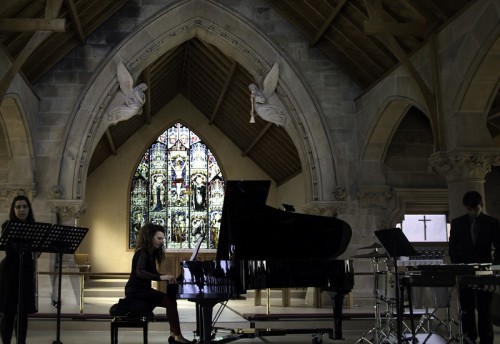FLANKED by stone angels in All Saints’ Church Ainslie, ensemble Press, Play performed the world premiere of Larry Sitsky’s Piano Trio No. 10, Sandakan.
This extraordinary work commemorates the death marches from Sandakan to Ranau in 1945, arguably the worst Japanese atrocity against Australian servicemen in WWII. Of the 2345 victims of these marches, more than 2000 were Australian. Pianist Sonya Lifschitz, flautist Lina Andonovska and percussionist Dan Richardson explored the work’s internal dramaturgy to evoke the vividness of human suffering.
Sitsky’s Sandakan’s loose tripartite structure reflects the three separate marches, of March, May and June 1945. Moving through progressively rising registers—as alto flute changes to C flute then piccolo (and back again)—the trio presents densities of energy and exhaustion—on the road to Ranau, those who fell down were executed.
It begins starkly. Two river stones are struck together like gunshots. As their sound dies away, an alto flute unwinds her slow melody over tremulous river stones, single notes lying low in the piano.
This sparse landscape is disrupted by agitato flute, tritone piano figures and xylophone tremolandi. There is terror in these phrases, sorrow too. A klangfarbenmelodie texture unifies, transforms itself into expressive piano chords outlined by xylophone (a device similar to Lutoslawski). This feature of division and unity is central to this trio—things fall apart, the centre does not hold.
By the change from alto flute to C flute (the second march) all three voices are integrated. The texture is closer now to that of an expanded single instrument than to chamber music. Subdued tam-tam and a grave piano give way to creeping passages—portentious and building gravely. The piano erupts to fist-pummelled cascades and the shouting of tom-toms.
Here Sitsky’s Sandakan explores that region between anger and sorrow—the cacophony thins, giving way to stark flute and the deep pathos of piano. Again and again, Sitsky’s phrases build to cyclone and dissolve into a bare sky.
Andonovska’s piccolo brings the lyricism of a violin’s top register to the last march. Joined by glockenspiel, the piccolo rises over piano chords as birdsong. This is Sitsky calling the dead, we remember Messiaen at Stalig VIII watching birds fly to freedom over the barbed wire fence. All movement is fast—piccolo trills and mordents, the piano’s extreme top register, build to an almighty percussion cadenza.
A strident piccolo sounds the alarm. Escalating into scream, it deconstructs over tom-toms and repeated piano figures. The music is desperate. Each instrument disconnected from the others. And when the three lines finally rejoin, they are spread over a vast registral distance—piano in the extreme bass, piccolo in the stratosphere. It is the percussion that creates order. Military tattoos in the tom-toms unifies the ensemble into a regulated march, and for a while it holds.
Gradually, step by step, flute and piano succumb to exhuation and falter. A single tam-tam resounds into the stillness; an open plain where nothing is left alive. Xylophone, like the rattling of bones.
From this desolate soundscape, Sitsky recapitulates the opening mood—alto flute and piano, a tremble of river stones. But this is no simple repeat. The end knows more than the beginning—something has been transformed. River rocks, struck together twice, resound and die out in the silent church.
A performance like this grips an audience so tightly they are left bewildered when it ends. The emotional intensity drifts away and hopefully someone has the presence of mind to applaud. “Wonderful” I heard someone say as they put on their coat “wonderful”. I remembered stories of the first performance of Penderecki’s Threnody to the victims of Hiroshima and wondered what those listeners might have muttered, putting on their coats. Like Penderecki’s counterpart, Sitsky’s Sandakan deals with emotions so strong that only music can convey them—words, after music like this, are impotent.
The post Review / Sitsky work commemorates Sandakan death marches appeared first on Canberra CityNews.
